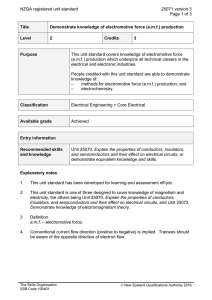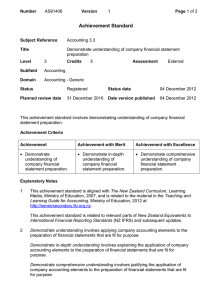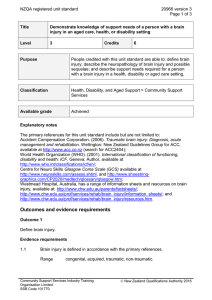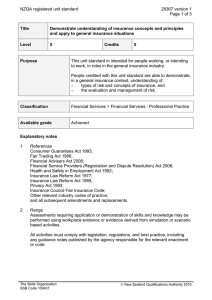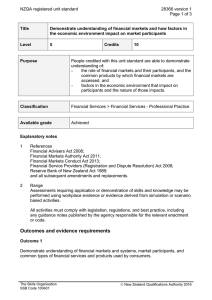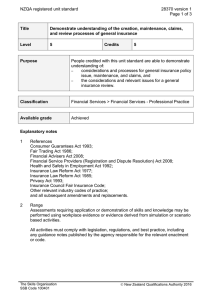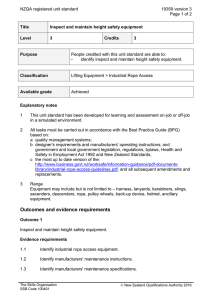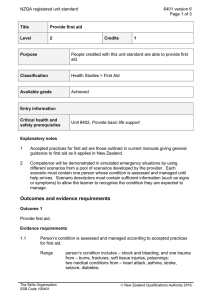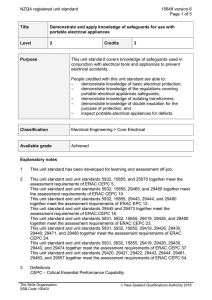25071 Demonstrate knowledge of electromotive force (emf
advertisement
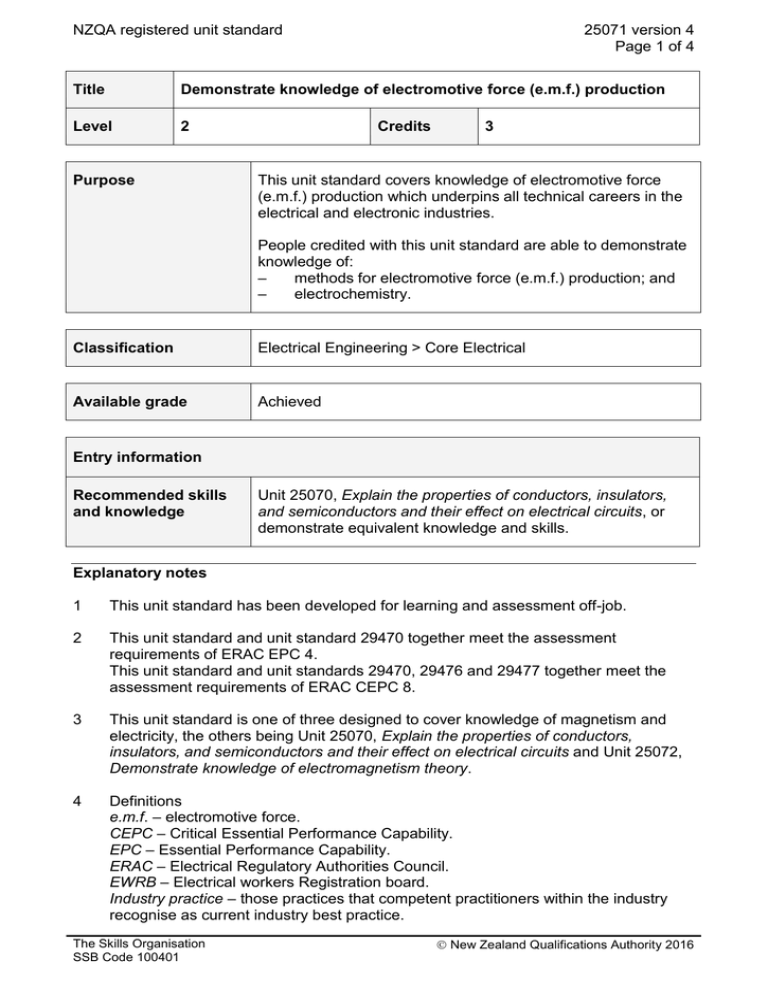
NZQA registered unit standard 25071 version 4 Page 1 of 4 Title Demonstrate knowledge of electromotive force (e.m.f.) production Level 2 Purpose Credits 3 This unit standard covers knowledge of electromotive force (e.m.f.) production which underpins all technical careers in the electrical and electronic industries. People credited with this unit standard are able to demonstrate knowledge of: – methods for electromotive force (e.m.f.) production; and – electrochemistry. Classification Electrical Engineering > Core Electrical Available grade Achieved Entry information Recommended skills and knowledge Unit 25070, Explain the properties of conductors, insulators, and semiconductors and their effect on electrical circuits, or demonstrate equivalent knowledge and skills. Explanatory notes 1 This unit standard has been developed for learning and assessment off-job. 2 This unit standard and unit standard 29470 together meet the assessment requirements of ERAC EPC 4. This unit standard and unit standards 29470, 29476 and 29477 together meet the assessment requirements of ERAC CEPC 8. 3 This unit standard is one of three designed to cover knowledge of magnetism and electricity, the others being Unit 25070, Explain the properties of conductors, insulators, and semiconductors and their effect on electrical circuits and Unit 25072, Demonstrate knowledge of electromagnetism theory. 4 Definitions e.m.f. – electromotive force. CEPC – Critical Essential Performance Capability. EPC – Essential Performance Capability. ERAC – Electrical Regulatory Authorities Council. EWRB – Electrical workers Registration board. Industry practice – those practices that competent practitioners within the industry recognise as current industry best practice. The Skills Organisation SSB Code 100401 New Zealand Qualifications Authority 2016 NZQA registered unit standard 25071 version 4 Page 2 of 4 Outline – to indicate the main features of a topic or sequence of events possibly setting them in a clear framework to show how they interrelate. Safe and sound practice – as it relates to the installation of electrical equipment is defined in AS/NZS 3000:2007, Electrical Installations (known as the Australian/New Zealand Wiring Rules). 5 Range a Conventional current flow direction (positive to negative) is implied. Trainees should be aware of the opposite direction of electron flow. b Candidates may refer to current legislation and Standards during assessment. c Demonstration of safe working practices and installation in accordance with safe and sound practice are essential components of assessment of this unit standard. d All activities and evidence presented for all outcomes and evidence requirements in this unit standard must be in accordance with: i legislation; ii policies and procedures; iii ethical codes; iv Standards – may include but are not limited to those listed in Schedule 2 of the Electricity (Safety) Regulations 2010; v applicable site, enterprise, and industry practice; and, vi where appropriate, manufacturers’ instructions, specifications, and data sheets. Outcomes and evidence requirements Outcome 1 Demonstrate knowledge of methods for e.m.f. production. Range chemical, magnetic, friction, piezoelectric, photoelectric, thermocouple. Evidence requirements 1.1 Describe methods of producing an e.m.f. in terms of how it is achieved and the relative magnitude of the voltage produced. 1.2 State an example of a common device using each method of generation. Outcome 2 Demonstrate knowledge of electrochemistry. Evidence requirements 2.1 Describe the construction and operation of a primary cell and of a lead-acid battery with the aid of labelled sketches. Range 2.2 the descriptions and diagrams should reflect an understanding of the terms – primary cell, secondary cell, battery, electrolyte, specific gravity, electrodes, cathode, anode, charging, discharging; details of chemical reactions are not required. Define battery capacity in terms of current and time. The Skills Organisation SSB Code 100401 New Zealand Qualifications Authority 2016 NZQA registered unit standard 2.3 25071 version 4 Page 3 of 4 Outline characteristics and typical applications of cells in terms of practical aspects and safety. cells may include but are not limited to – lead-acid, deep-cycle lead-acid, lithium iron phosphate, mercury, nickel-cadmium, nickeliron, nickel metal hydride; practical aspects – voltage, capacity, charge/discharge characteristics; safety – charge/discharge characteristics, disposal; evidence for four cells required. Range 2.4 Outline precautions that ensure safe charging of lead-acid batteries in accordance with industry practice. 2.5 Outline situations where electrical energy creates a chemical effect. Range electroplating, corrosion, battery charging. 2.6 Describe electrochemical corrosion in terms of electrode potentials between metals and electrolytic action of surroundings. 2.7 Outline methods of reducing corrosion. methods – alloying, protective coatings, cathodic protection, neutralising of environment. Range Replacement information This unit standard, unit standard 25070, and unit standard 25072 replaced unit standard 15843. Planned review date 31 December 2019 Status information and last date for assessment for superseded versions Process Version Date Last Date for Assessment Registration 1 22 August 2008 31 December 2021 Rollover and Revision 2 15 March 2012 31 December 2021 Revision 3 15 January 2014 31 December 2021 Review 4 21 July 2016 N/A Consent and Moderation Requirements (CMR) reference 0003 This CMR can be accessed at http://www.nzqa.govt.nz/framework/search/index.do. The Skills Organisation SSB Code 100401 New Zealand Qualifications Authority 2016 NZQA registered unit standard 25071 version 4 Page 4 of 4 Please note Providers must be granted consent to assess against standards (accredited) by NZQA, before they can report credits from assessment against unit standards or deliver courses of study leading to that assessment. Industry Training Organisations must be granted consent to assess against standards by NZQA before they can register credits from assessment against unit standards. Providers and Industry Training Organisations, which have been granted consent and which are assessing against unit standards must engage with the moderation system that applies to those standards. Requirements for consent to assess and an outline of the moderation system that applies to this standard are outlined in the Consent and Moderation Requirements (CMR). The CMR also includes useful information about special requirements for organisations wishing to develop education and training programmes, such as minimum qualifications for tutors and assessors, and special resource requirements. Comments on this unit standard Please contact The Skills Organisation at reviewcomments@skills.org.nz if you wish to suggest changes to the content of this unit standard. The Skills Organisation SSB Code 100401 New Zealand Qualifications Authority 2016
